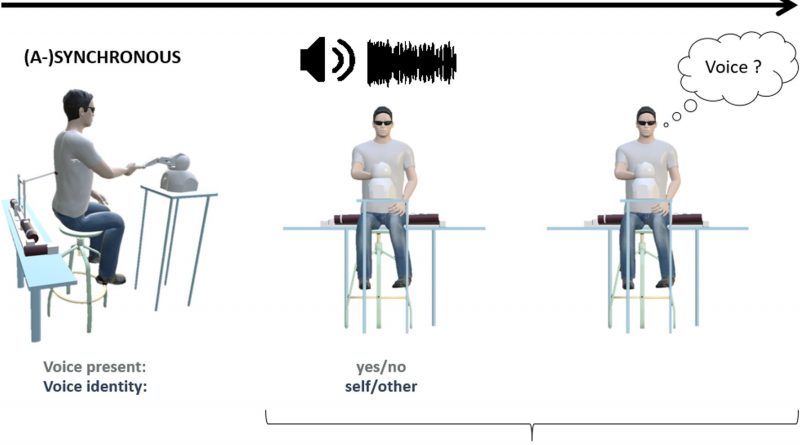Inducing auditory hallucinations in a lab environment without using drugs

A team of neuroscientists and psychologists at École Polytechnique Fédérale de Lausanne, working with a colleague from University Savoie Mont Blanc, CNRS, LPNC, has found that it is possible to induce auditory hallucinations in mentally healthy people without using drugs.
In their study, reported in the journal Psychological Medicine, the group conducted experiments in which they robotically induced auditory–verbal hallucinations in volunteers.
Several years ago, members of the same team found that it was possible to induce a form of sensory hallucination in volunteers using a push-button device. In those experiments, volunteers were asked to sit in a chair and push a button—once they did so, after a slight pause, a small, finger-sized rod was pushed gently against their back.
After undergoing multiple sessions, the volunteers began to feel as if there was someone standing behind them. The research team suggested the reaction was due to a disconnect between their action (pushing a button) and the time-lapsed sensation they experienced. In this new effort, the researchers used the same apparatus to conjure auditory hallucinations in volunteers.
In this new study, 48 volunteers sat in a chair and pushed a button, as in the first experiments. Once again, this resulted in a tiny poke in the back—but this time, the research team varied the delay between the button push and the jab. Once again, the volunteers began to feel a presence behind them. In this experiment, the researchers also added headphones that played a soft form of white noise. In addition, some of the recordings randomly played samples of the volunteers’ own voices or samples of someone else’s voice. In all sessions, each volunteer was asked if they heard a voice coming from the headphones.
The researchers found that once a volunteer began to feel a presence behind them, they sometimes began to hear voices (that were not there) coming through the headphones. Their brains were making up a voice to go with the “ghost” standing behind them—they also found it was more common if they had heard someone else’s voice coming through the headphones first.
The research team also found that some of the volunteers who experienced the poke in the back without a time lag, and thus did not feel the presence behind them, sometimes also heard voices that were not there—but only if they had heard their own voices coming through the headphones first.
More information:
Pavo Orepic et al, Robotically-induced auditory-verbal hallucinations: combining self-monitoring and strong perceptual priors, Psychological Medicine (2023). DOI: 10.1017/S0033291723002222
Journal information:
Psychological Medicine
Source: Read Full Article
